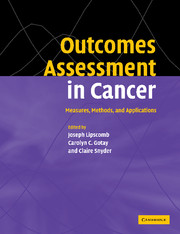Book contents
- Frontmatter
- Contents
- List of contributors
- Acknowledgments
- 1 Introduction to Outcomes Assessment in Cancer
- Health-related quality of life in cancer: general concepts and generic measures
- Assessing health-related quality of life during treatment
- Assessing health-related quality of life across the cancer continuum
- Measuring the experience and needs of cancer patients and caregivers
- Methodological considerations in applications to cancer outcomes research
- Modern psychometric theory in cancer outcomes research
- Assessing the economic impact of cancer
- Research and policy implications
- 26 Data for cancer outcomes research: identifying and strengthening the empirical base
- 27 Use of health-related quality of life measures by industry and regulatory agencies in evaluating oncology therapies
- 28 Reflections on COMWG findings and moving to the next phase
- Invited papers
- Index
- References
26 - Data for cancer outcomes research: identifying and strengthening the empirical base
Published online by Cambridge University Press: 18 December 2009
- Frontmatter
- Contents
- List of contributors
- Acknowledgments
- 1 Introduction to Outcomes Assessment in Cancer
- Health-related quality of life in cancer: general concepts and generic measures
- Assessing health-related quality of life during treatment
- Assessing health-related quality of life across the cancer continuum
- Measuring the experience and needs of cancer patients and caregivers
- Methodological considerations in applications to cancer outcomes research
- Modern psychometric theory in cancer outcomes research
- Assessing the economic impact of cancer
- Research and policy implications
- 26 Data for cancer outcomes research: identifying and strengthening the empirical base
- 27 Use of health-related quality of life measures by industry and regulatory agencies in evaluating oncology therapies
- 28 Reflections on COMWG findings and moving to the next phase
- Invited papers
- Index
- References
Summary
Introduction
It is clear from earlier chapters that data for measuring, interpreting, explaining, and predicting cancer outcomes are currently available from a variety of sources. Cancer registries, medical records, administrative claims data, and patient and provider surveys yield, individually or in concert, information about a range of outcomes that matter to decision makers. These outcomes include not only survival, disease-free survival, tumor progression, and a host of other biomedical endpoints, but important patient-reported outcomes that are the focus of this book — health-related quality of life (HRQOL), patient perceptions of and satisfaction with care, and the economic burden of cancer and its treatment. Moreover, these same data sources also yield, with varying degrees of completeness, information on a variety of factors associated with variations in cancer outcomes. These include socioeconomic and other demographic descriptors, comorbidities and other clinical determinants, and provider and health system variables.
At the moment, no single database or system provides sufficiently comprehensive information on the full range of variables required for cancer outcomes research. Rather, what we have is a substantial number of public agencies and private organizations doing an increasingly good job at collecting important pieces, components, and parts of the data required for the cancer outcomes research agenda of today and tomorrow.
In the immediate future and beyond, new prevention, diagnostic, treatment, and palliative modalities will continue to emerge. Public and private payment systems will continue to evolve, as pressures for both cost containment and quality assurance grow.
- Type
- Chapter
- Information
- Outcomes Assessment in CancerMeasures, Methods and Applications, pp. 522 - 549Publisher: Cambridge University PressPrint publication year: 2004
References
- 1
- Cited by

